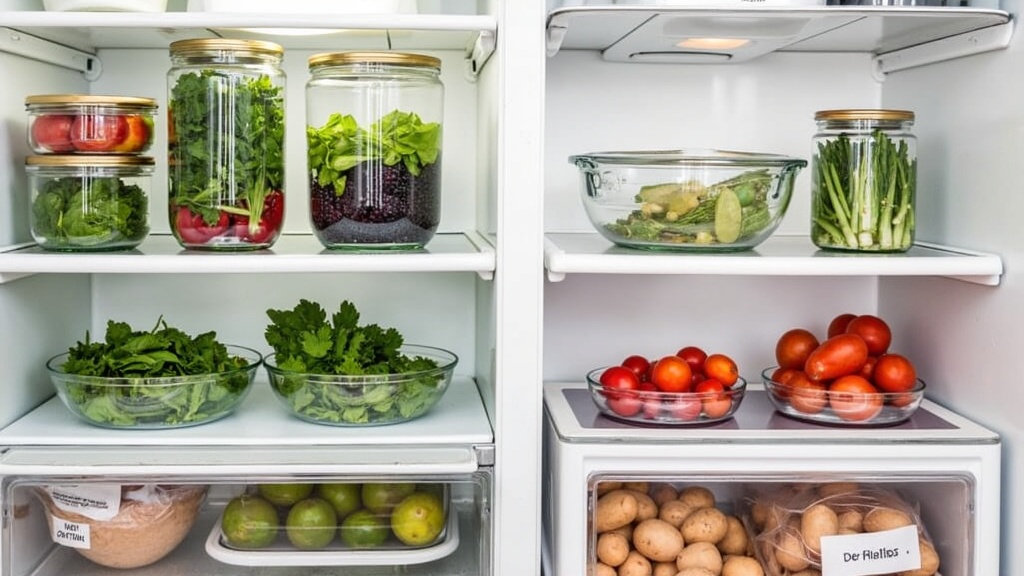If you want your produce to last longer than a teenager’s attention span, here’s the trick: keep it dry, control the humidity, and don’t shove everything into the fridge like it’s a junk drawer. Taking a little time to store your fruits and veggies right doesn’t just keep things fresher. It seriously helps you save money and reduce waste.

Why Proper Produce Storage Matters
Storing produce the right way isn’t just about looking organized. Fresh fruits and veggies have different needs. Ignoring those means you’ll end up tossing out wilted kale or mushy strawberries. According to the USDA, about 30-40% of the food supply in America gets wasted, much of it from spoilage in home kitchens. If you make a few tweaks to your produce storage game, you’ll actually use what you buy instead of fishing out slimy salad greens a week later.
The key factors that mess with your produce are excess moisture, improper temperature, and poor airflow. Fruit and veggies don’t all play well together, either. Some release gases that cause their neighbors to ripen, which leads to faster rotting. Apples are a prime suspect here. If you start thinking about what each type of produce likes, your groceries will last a lot longer and taste better. You’ll also find that fresher veggies can make meal prep easier and more enjoyable. Plus, getting creative with storage can help you avoid unnecessary grocery runs.
Where to Store Different Produce
Not all produce belongs in the fridge, even though it’s tempting to toss everything in there. Some items thrive in the chilly air, while others actually last longer outside.
- Pantry or Counter: Tomatoes, potatoes, onions, garlic, and winter squash all prefer a cool, dark spot. Refrigeration gives them odd flavors or makes their textures strange, so steer clear of cold storage for these whenever possible.
- Fridge (Crisper Drawer): Leafy greens, carrots, broccoli, berries, apples, citrus, and peppers like it cold but not too damp. The crisper drawer is handy because you can tweak the humidity. Just don’t crowd it—empty space lets air move around and keeps things fresher.
- Out On The Counter: Bananas, avocados, peaches, and melons do fine at room temperature until they’re fully ripe. Once they’re perfect, pop them in the fridge to hang on for a couple extra days of snack readiness. If your fruit bowl sits in direct sunlight, consider moving it to a shadier spot to avoid speedy spoilage.
Top Produce Storage Tips
Moisture is the enemy. Dry your produce before storing it or you’ll have wilted lettuce soup in no time. Ethylene gas, which some fruits give off, can speed up ripening and rotting in sensitive veggies. Berries, greens, herbs, and crunchy things each have their own preferences, too. Ignoring these results in a lot of wasted food, so try these go-to solutions:
- Leafy greens (spinach, lettuce, kale): Rinse, spin or pat dry, and tuck into a container with a paper towel to soak up any extra drops. Too much moisture and you’ll be dealing with salad sludge. Also, loosely pack these to give them space and keep things crisp.
- Herbs (cilantro, parsley): Trim the ends and stand them upright in a jar with a bit of water, cover loosely with a bag, and store in the fridge. They’ll stay perky longer, much like flowers.
- Berries and grapes: Rinse just before eating, but if you like prepping, give them a quick dunk in a 1:3 vinegar-water solution first, then dry thoroughly. Store in vented containers to avoid getting mushy. If you have a berry saver container, now’s the time to use it!
- Celery: Wrap it in foil to keep it crisp for weeks. The foil lets out the right amount of moisture while trapping enough to keep things crunchy and snappy.
- Asparagus: Trim the ends and stand in a glass of water, cover loosely with a bag, and refrigerate. This spa treatment helps it stay snappy for longer time periods, making it easier to use in recipes.
- Apples, avocados, bananas: Keep them away from other produce if you can. Their ethylene gas will make sensitive neighbors go downhill fast. Separate storage helps everything last longer, so try using different bowls on opposite ends of the counter if you’re tight on space.
Step-by-Step Guide: How To Store The Most Common Fruits And Veggies
Sorting produce by needs isn’t just a nerdy project; it actually prevents most of the common food flops you see in the crisper. Here’s how I handle the groceries when I get home and some extra tips I’ve learned along the way:
- Sort right away: Go through bags and sort produce by storage place (fridge, pantry, or counter). Wipe off any visible dirt, but don’t wash things like mushrooms until you use them. This stops premature spoilage and makes prepping meals faster later on.
- Dry everything well: Pat leafy greens and berries dry before storing to prevent soggy messes. A salad spinner is pretty handy for this. You can also roll greens in a dry kitchen towel if you don’t have a spinner.
- Treat herbs like bouquets: Trim and stand in water if storing in the fridge, or wrap in a damp towel and seal in a bag for softer herbs like basil. Basil gets cold-damaged easily, so keep it at room temperature when possible.
- Use produce-specific spots: Crisper drawers usually have adjustable humidity. Greens and veggies like it high; fruits and ethylene-producers (like apples) thrive with lower humidity. Labeling drawers can help everyone in your home remember what goes where.
- Don’t choke your produce: Airflow really helps, so use paper bags, mesh produce bags, or leave store packaging slightly open unless it’s purpose built for storage. Proper ventilation prevents mold and extends shelf life.
- Keep things separate: Store onions, potatoes, and garlic in different baskets or rooms if you can. Onions and garlic can make potatoes sprout faster and vice versa. Keeping them apart really makes a difference.
- Rotate & check weekly: Take a couple minutes every week to check the back of the fridge or the bottom of the fruit bowl for anything starting to fade. Eat the older stuff first so it doesn’t end up wasted. Making this a regular habit helps you cut back on spoiled produce and keeps your fridge fresh.
Challenges and Solutions: Common Storage Mistakes
I’ve seen friends stuff everything into their veggie drawer and wonder why it all goes bad at once. Here are a few common slip-ups, and easy fixes you can try next time you unload your shopping haul:
- Leaving everything wet: Moisture invites mold and speeds up rotting. Dry produce as much as possible before storing. Keep a clean dish towel handy and don’t pack things away wet.
- Overcrowding the fridge: Packed drawers mean no air movement. Space things out by using bins, which you can even label by day for extra credit. This also helps you spot what’s going bad before it’s too late.
- Mixing ethylene producers and sensitive veggies: Apples, bananas, and avocados age leafy greens and root veggies fast. Store them apart. This little habit saves you from weekly wilted greens.
- Funky fridge temps: Keep your fridge at around 37°F (3°C) for best results. Too warm or too cold and everything goes off faster, especially tender produce like berries and greens.
- Ignoring expiration dates on prepackaged items: Tap on bags of salad greens or precut carrots to check for excess moisture. If you see it, swap the bag for a paper towel-lined glass container. It buys you a few extra days.
Produce Storage Hacks You’ll Actually Use

Some simple habits and gear make a difference. Try these practical tricks to make healthy snacks easy to grab and help your produce last:
- Reusable produce bags: Mesh or cloth bags give veggies and fruits air to breathe, unlike plastic which traps moisture. They’re also easy to toss in the wash if something leaks.
- Glass containers: Great for storing chopped produce. Add a paper towel to catch excess moisture, especially for carrots or peppers. Transparent containers let you see what’s inside, so nothing gets forgotten in the back.
- Label & date: Even a bit of masking tape helps you keep track of what needs to be eaten soon. Use a marker to jot the date, and rotate old items to the front.
- Prep for the week: Wash and store snack-ready veggies in containers for easy access—carrot sticks, snap peas, cucumber slices. Makes healthy eating way more convenient and reduces midweek meal prep hassle.
- Use produce-saving gadgets: There are storage boxes designed to wick away excess moisture or keep produce separate. These are worth it if you buy a lot of fresh ingredients each week.
Real-Life Examples: What Works and What Doesn’t
- Tomatoes: A friend of mine used to always put tomatoes in the fridge, but they lost flavor and got mealy. Now we both let them ripen on the counter and eat them up before they start to get too soft. Sometimes, slicing tomatoes just before eating brings out the best taste and texture.
- Lettuce: One week, I forgot to dry lettuce before bagging it. Result? Instant soggy leaves. Switched to drying and tucking in a paper towel, and now it lasts way longer. If you want extra crispness, soaking lettuce in ice water for 20 minutes before spin-drying helps a lot.
- Berries: Vinegar rinses and vented containers have saved me from the dreaded moldy berry surprise more times than I can count. Worth trying if you eat a lot of fruit. My kids are more likely to snack healthy when I keep a bowl of clean, ready-to-eat berries in the fridge.
- Carrots: I found that peeling and chopping carrots ahead of time and storing them in water in a glass container keeps them crisp for a week. Plus, they’re grab-and-go for snacks or quick recipes.
Frequently Asked Questions
How can I keep cut produce fresh longer?
Store cut fruits and veggies in airtight glass or BPA free containers with a dry paper towel to absorb extra moisture. Use them within a few days for the best flavor and crunch. If you notice any droplets inside, swap the towel for a fresh one.
Is it better to wash produce before storing?
Most items stay freshest if washed right before you eat them. For greens or berries, if you want to wash ahead, make sure everything is dry before putting it away to avoid mold. With hardy veggies like carrots or celery, prepping in advance is safe as long as everything is kept dry.
Does storing apples with other produce really matter?
Yes! Apples give off ethylene gas, which speeds up ripening in other fruits and makes greens wilt faster. Keep apples separate for less food waste. If you don’t have much space, bag apples and store them in a fridge drawer away from other fruits.
Taking Care of Your Produce (and Your Wallet)
Store produce like you actually want to eat it, not like you’re hiding it from yourself. Keeping things dry, cool, and sorted helps everything stay fresher, longer. Your fridge will thank you—and so will your wallet. Get your storage routine down, and you’ll find yourself tossing less and using up more of what you buy. Fresh ingredients on hand also make healthy eating so much easier, whether you’re cooking for yourself, friends, or family. Plus, the more you practice these tips, the more second nature they’ll become, so every trip to the store pays off big in flavor and savings.
